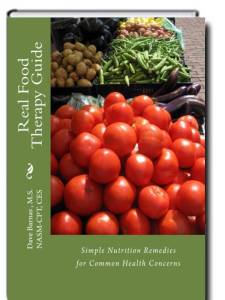 Since many clients, readers and friends have shared mixed experiences with the effects of glucosamine and chondroitin on their joints, I wanted to spotlight some recent related research. Not surprisingly, millions of Americans take glucosamine, often with chondroitin sulfate, for the aches and pains of osteoarthritis. Over the years, research has yielded inconsistent findings, but I am happy to share more recent studies, which provide new insights to consider.
Since many clients, readers and friends have shared mixed experiences with the effects of glucosamine and chondroitin on their joints, I wanted to spotlight some recent related research. Not surprisingly, millions of Americans take glucosamine, often with chondroitin sulfate, for the aches and pains of osteoarthritis. Over the years, research has yielded inconsistent findings, but I am happy to share more recent studies, which provide new insights to consider.

Glucosamine and chondroitin sulfate are produced in the human body and are involved in the production and maintenance of the cartilage that cushions joints. The supplement glucosamine is manufactured from shellfish; chondroitin, usually from cow bone. It’s claimed that they cure or alleviate arthritis pain, help build cartilage and cushion the joints, and prevent deterioration of cartilage.
What the studies show:
In 2006 the government-sponsored Glucosamine/chondroitin Arthritis Intervention Trial (GAIT) reported that neither glucosamine hydrochloride nor chondroitin sulfate, alone or together, reduced pain and other symptoms significantly better than a placebo. (The prescription pain reliever Celebrex, also tested, fared only slightly better.)
But what about the main claim made for these supplements—that they slow or prevent the deterioration of joint-cushioning cartilage that is the hallmark of arthritis? In 2008 results of the second part of the study answered this question. The first GAIT study lasted six months and included 1,600 people with osteoarthritis of the knee, the joint that’s most likely to cause pain and loss of mobility. In the follow-up study, 357 of these subjects continued treatment (glucosamine, chondroitin, both supplements together, Celebrex, or placebo) for an additional 18 months and then had X-ray exams to measure cartilage loss.
The exams found insignificant differences in cartilage loss between the groups. Interestingly, glucosamine and chondroitin did worse when taken together than alone, but nothing worked much better than the placebo.
Also in 2008, a Dutch study of 222 people with arthritis of the hip found that another form of glucosamine (sulfate) did not reduce pain or stiffness better than a placebo, and X-rays revealed no differences.
More discouraging news about glucosamine came in July from a well-designed study from Norway. It included people with low back pain and arthritis of the lower spine, half of whom took glucosamine sulfate (1,500 milligrams a day), the other half a placebo. After six months, both groups reported similar levels of disability, pain, and overall quality of life. That is, glucosamine worked no better than a placebo.
Bottom line
Americans spend billions of dollars every year on unproven arthritis remedies including glucosamine. There is no cure, but everything (including a placebo) seems to work at least for some people for a while. The placebo in the GAIT study helped relieve symptoms in a whopping 60% of subjects, about the same as the supplements. Pain relievers help many arthritis sufferers but don’t affect the underlying loss of cartilage. Discuss the options with your doctor. You may want to forget about glucosamine and chondroitin—unless you are willing to pay $20 or more a month for what is probably a placebo effect. If you already take these supplements and think they help, continue with them, but preferably with a product meets quality standards as provided in our blog on glucosamine and chondroitin. To evaluate whether they are helping you, consider stopping for a while to see if there’s a difference.
Discover more Tested and True supplements…
Go to Spotlight: Supplements – Tested and True: Defined
Go to Spotlight: Supplements – Tested and True: Fish Oil
Go to Spotlight: Supplements – Tested and True: Krill Oil
Go to Spotlight: Supplements – Tested and True: Multivitamins
Go to Spotlight: Supplements – Tested and True: Vitamin D
Go to Spotlight: Supplements – Tested and True: Calcium
Go to Spotlight: Supplements – Tested and True: Coenzyme Q10 (CoQ-10)
Go to Spotlight: Supplements – Tested and True: Glucosamine and Chondroitin
Go to Spotlight: Supplements – Tested and True: Probiotics
Go to Spotlight: Supplements – Tested and True: Muscle Enhancers – Creatine
Go to Spotlight: Supplements – Tested and True: Muscle Enhancers – Branched Chain Amino Acids (BCAAs)
Go to Spotlight: Supplements – Tested and True: Nutrition Bars
Go to Spotlight: Supplements – Tested and True: Nutrition Drinks & Powders
Go to Spotlight: Supplements – Tested and True: Weight Loss Accelerators and Appetite Controllers
Go to Spotlight: Supplements – Tested and True: Mood Booster SAM-e
Go to Spotlight: Supplements – Tested and True: Mood Booster St. Johns’ Wort
Get Your Free on Inspired Living™ e-newsletter, plus Free Real Food Therapy Guide
Download Included Free!
Watch This, Feel Inspired
*reference: Consumer Reports Health, 2012.





2 replies on “Glucosamine and Chondroitin: Real or Placebo Effect?”
This is such a timely post for me since I have been contemplating purchasing some form of joint supplement. With the marketing that goes into these products it becomes difficult to determine if they truly can live up to the hype. I appreciate you posting this.
Thanks Lynn. Happy to hear you enjoyed the post and I appreciate you taking the time to share your thoughts. The dietary supplement industry is so vast and lucrative, which makes it tough to determine what is a safe and quality product these days, especially with all the marketing. Having studied the dietary supplement industry for some time, one consideration I share with friends and clients who are thinking about a dietary supplement or who are taking them already is to be sure that the product is either USP verified or NSF certified. These two respective denotations validate the quality of a dietary supplement product on the market and allow a consumer to know they are purchasing a quality product. If you would like me to send you the website links that show the products that are USP verified and NSF certified, please send me an e-mail me at dave@truehealthunlimited.com